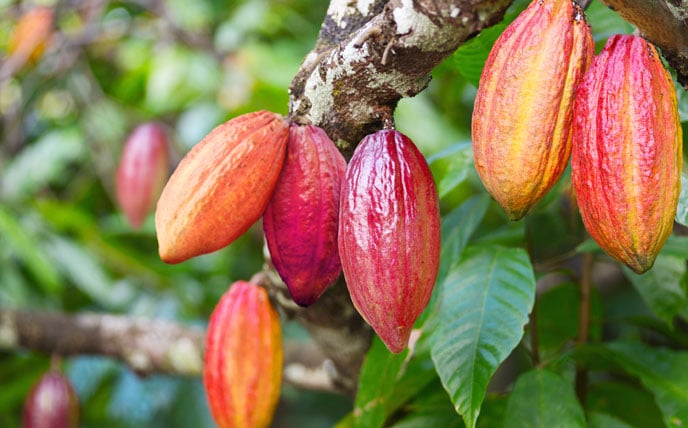How to grow organic cocoa

Cocoa pods hanging on a tree in a plantation. Photo | File
What you need to know:
- Organic production practically eliminates the use of costly external inputs such as plant protection substances and fertilisers. By not using these, farmers can significantly decrease their operating costs.
Cocoa grows well on a wide range of soils but lose soils that allow movement of air and moisture, and root penetration is ideal.
It must hold moisture in the soil during the dry season, as cocoa needs a regular supply of moisture for good growth. Cocoa can be grown in soils having a pH value range from 4.0 and 7.5; it succeeds better in neutral soil.
Certified organic agriculture is the production by agreed-upon standards for organic agricultural practices. These standards include an annual inspection process, and those certify that the organic crop has been produced and handled with no prohibited substances (synthetic paraquat and pyrethroids) or synthetic chemicals.
The organic crop must also have been grown on land to avoid the application of these substances for a minimum of three years. Each organic agricultural operation must use an “organic plan” agreed upon by both the certifier and the grower.
It must detail all parts of the agricultural production of the certified crop. This mainly includes soil management, pest controls, post-harvest techniques, crop rotation, biological inputs, storage, handling, and document tracking.
Advantages
Organic production practically eliminates the use of costly external inputs such as plant protection substances and fertilisers. By not using these, farmers can significantly decrease their operating costs. External inputs are substituted with local inputs. For example, expensive hybrid seeds are replaced with locally kept seeds and chemical fertilisers are replaced with compost. This decreases costs and increases farmers’ sovereignty by making them less dependent on big companies and money.
Higher prices
Those cocoa beans produced organically also command a higher price in the international marketplace compared to conventional ones. So, the reduced input costs and the improved prize per tonne of organic beans leads to a higher farm income, overall.
Environmental and health benefits
Organic cocoa production is more naturally sustainable than conventional production.
This is attained through avoidance of pollution and healthier production methods such as agroforestry. Also, by avoiding hazardous chemicals such as insecticides and pesticides, the health of cocoa farmers is protected. This increases farmers’ income.
And organic production encourages intercropping of the cocoa plantation with numerous other useful crops such as shade trees, bananas, pineapples, oil palms, and jackfruit.
Each of these provides the farmers with additional income and food sources, further helping farmers to become independent of having to buy food.
Organic soil preparation
The soil on cocoa plantations must be well-drained, deep, and have sufficient water absorbent capacity. The pH-value of soil should be between 4.0 and 7.5, whereby care must be taken that sufficient organic material is available.
Cocoa is a crop of humid tropics needing well-distributed rainfall. At least 90 to 100mm rainfall per month with annual precipitation of 1500 to 2000mm is ideal.
It can also be grown in other regions by supplementing rainfall with irrigation in dry periods. Though, for successful cultivation, the dry months must not exceed 3 to 4 months.
Cocoa tolerates a minimum temperature of 15°C and a maximum of 40°C, but a temperature around 25°C is considered as best. Cocoa can be grown in place from sea level up to an elevation.
Organic matter content is thus a significant factor, next to the clay content. Clay soils are likely to have greater quantities of nutrients as they have a greater ability to hold them.

An agronomist displays how one can prune their cocoa plant during the Seeds of Gold Farm Clinic. Photo | George Katongole
Soil nutrient
Soil nutrient management is serious to the general health of the tree, mainly where cocoa is grown on poor soils with short nutrient levels. The fertility of soils under cocoa plantations with whole canopy formation can be maintained or sustained for a fairly long time due to the ability of cocoa to recycle nutrients back into the soil. Though, nonstop harvesting will eventually result in the loss of soil nutrients.
Planting procedure
When starting a new plantation, it is more important to include crop successions. Intercrops can be done by planting papaya, bananas, and pineapples and reducing them as the cocoa trees develop. These intercrops increase cocoa tree growth, soil fertility, food availability, and farm income.
Spacing between cocoa at the time of planting is usually strongly based on traditions. Spacing can vary between 2.5 m x 2.5 m (if you follow this spacing you can easily plant nearly 1,600 plants per hectare) and 5 m x 5 m (if you follow this spacing you can easily plant nearly 400 plants per hectare). The spacing of cocoa is mostly based on companion crops.
Organic fertiliser requirements
The use of organic fertilisers can address several problems and they are important for maintaining healthy soils.
Organic fertilisers can come from many sources including composts, farmyard (goat, chicken, cattle,) manure, and ‘plant teas’, which can act as liquid manures.
Chemical fertilisers are not used. These disturb the balance of vital soil biota, resulting in eutrophication of waters (pollution by too many nutrients), are too costly, and make farmers dependent on agrochemical firms.
Biological soil fertility improvements such as vermicomposting, compost, and fertiliser trees must be used instead; they stop all of these risks.
Pests
The cocoa plant can be affected by several diseases and pests, which thrive well in the humid and warm climates where cocoa is usually grown.

An agronomist displays how one can prune their cocoa plant during the Seeds of Gold Farm Clinic. Photo | George Katongole
Though, with proper implementation and understanding of a natural agroecosystem, diseases and pests can efficiently be managed.
Do not use any kind of chemical pest controls in this system. The conventional chemicals upset the systems equals by killing pest predators, being poisonous to humans and animals, and results in damage further downstream in the ecosystem.
Instead, cultural or biological methods must be used. For example, take away and bury cocoa-pods affected by black pod disease. Such methods do not kill pest predators, are less costly and nontoxic, and are so better for farmers and their environment.
Under organic certification standards, no synthetic chemical fertiliser, synthetically compounded pesticide or genetically engineered crops may be used. Farmers use cover crops, compost, manures, and naturally occurring pest control materials.
How to harvest cocoa beans
Pods containing cocoa beans grow from the branches and trunk of the cocoa tree. Harvesting includes take away ripe pods from the trees and opening them to extract the wet beans.
With the help of a well-sharpened blade, the cocoa pods can be harvested manually by making a clean cut through the stalk.
The pricing of the cocoa beans will completely base on the quality of beans. It is so important to ensure the highest possible quality of the beans.
For achieving this, all steps of treatment of the beans should be handled with care, starting at harvest and ending at storage. Cocoa harvest begins when the fruits are completely ripe.
Postharvest steps
At a central area, cocoa-pods are collected, where pods are broken, husks removed and the white-yellowish seed masses are heaped together for fermentation.
Fermentation of cocoa
There are several ways in which farmers can involve in the process of cocoa fermentation. After the cocoa pulp and beans are removed from the husk, smallholders naturally cover the heaps of cocoa with banana or plantain leaves and let them ferment for nearly five days.
This traditional approach to fermentation, though, is prone to environmental risk factors. Periods of intense rainfall increase the time required for the fermentation process. Droughts, temperature changes, and prolonged dry seasons affect the overall quality and flavour of the product.
Drying of cocoa beans
After completion of fermentation, beans are transferred to drying mats or tables or other surfaces depending on the method.
During drying, the fermentation process is completed. The next step after the fermentation process is the drying of the cocoa beans.
Under insufficient methods and circumstances, drying can result in loss of quality and production losses. Artificial drying includes the use of an artificial source of heat like fires. Severe rainfall can cause moulding of cocoa beans and decrease quality. Drying takes about one week in the sun and gets the bean moisture down to about 7.5 %. Dried beans are sold in jute bags.




